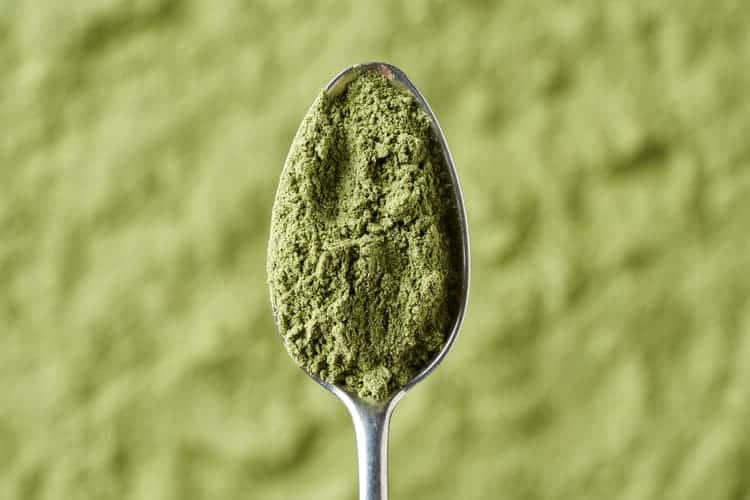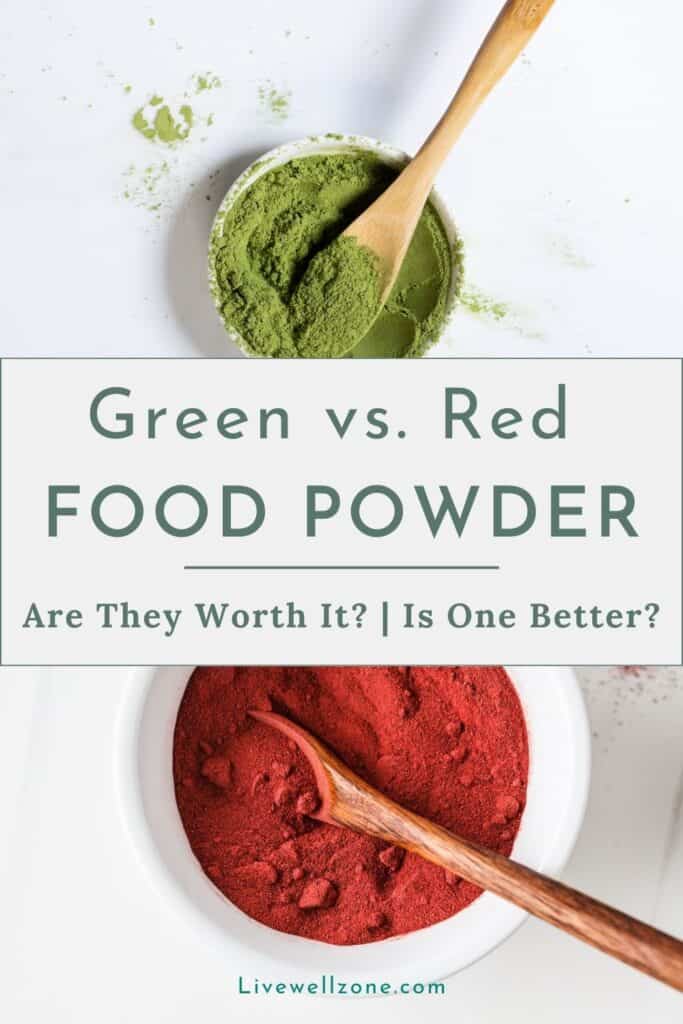
As red and green “superfood” powders continue to grow in popularity, you may be asking yourself:
- are they worth it?
- are they actually different, and if so, how?
- can I use them as a replacement for fruits and veggies?
This guide on green powder vs red powder is going to give you the answers to all of the above (and more)!
So, keep reading to learn more about these powders and how they fit into a healthy lifestyle.
NOTE: most of the information in this article comes from this medical review. All other references are identified throughout the article. This article also contains some affiliate links and I earn a commission (at no additional cost to you) if you use them to make a purchase.
WHAT IS THE DIFFERENCE BETWEEN GREEN AND RED POWDER?
The main difference between green and red powder is their phytochemical (aka phytonutrient) content. Green powder is made from food that is rich in chlorophyll (a green pigment) while red powder is made from food that is rich in lycopene (a red pigment).
Now, if you’re not familiar with phytochemicals, these are compounds found in plants (phyto means relating to or of plants).
These phytochemicals are nutrients and they have a multitude of health benefits.
In particular, phytochemicals tend to have antioxidants properties and have been studied for their ability to protect the body from cancer, premature aging, inflammation and more.
Below is a table that summarizes the main differences between red and green powder. For more details about each type of powder, keep reading.
| Green Powder | Red Powder |
|---|---|
| Contains chlorophyll. | Contains lycopene. |
| Usually includes green apple, leafy greens, cruciferous vegetables and algae. | Usually includes beets, strawberries, red apples and tomatoes. |
| Little to no fiber. | Little to no fiber. |
| Can be mixed with red powder. | Can be mixed with green powder |
| Provide nutrients that support various metabolic processes. | Provide nutrients that support various metabolic processes. |
BENEFITS OF GREENS POWDER

Green powders are made from fruits and vegetables that contain chlorophyll, a phytonutrient that lends a green hue to food.
The most popular ingredients in green powders are:
- Leafy greens (such as kale and spinach).
- Cruciferous vegetables (such as kale and broccoli).
- Green algae aka aquatic plants (such as spirulina and chlorella).
- Celery.
- Green apple.
Now, here’s an overview of how these ingredients can benefit you:
- Leafy greens are a good source of vitamin K1 (aka phylloquinone) which is essential for blood clotting, bone health and modulation of various cellular processes (source).
- As a natural source of nitrate, leafy greens are also great for supporting the cardiovascular system.
- Similar to leafy greens, cruciferous vegetables are also helpful for heart health.
- Cruciferous vegetables are notably high in sulfur-containing compounds (indoles, sulforaphane and isocyanate) that help to get rid of excess estrogen.
BENEFITS OF RED SUPERFOOD POWDER

Red powder is made from food that is rich in lycopene, a phytonutrient that lend reddish and pinkish hues to food (source).
Lycopene is best known for being an antioxidant, which means that it finds and neutralizes harmful free radicals.
As a result, lycopene protects us from heart disease, lung disease and prostate cancer (source).
Some of the most common ingredients in red superfood powders include:
- Strawberries.
- Tomatoes.
- Beets.
- Red apples.
- Cherries.
- Rosehips.
- Bell peppers.
Now, here’s an overview of how these foods can help you:
- They supply the body with vitamin C. This is because many red foods are also good sources of vitamin C (think acerola cherries, bell peppers, rosehips and tomatoes).
- Some studies indicate that red foods lower inflammation and help to reduce infections.
- Beets are rich in betalains, a family of compounds that may help with inflammation, oxidative stress and high cholesterol or triglycerides.
SO, ARE GREENS OR REDS MORE IMPORTANT?
All phytochemicals – whether red, green, orange, purple and so on – are beneficial and necessary. They all provide different health benefits and as such, one isn’t better than the other. Instead, you should strive to consume the entire rainbow of foods in order to support your overall health and well-being.
Furthermore, it’s important to note that food generally contains multiple phytonutrients.
So, even if a food looks green or red, it often contains other colors too. What we see is just the dominant color.
HOW TO USE RED AND GREEN POWDERS
As helpful as green and red superfood powders are, they are not a substitute for eating real foods. This is because these powders don’t contain the exact same nutritional profile of whole food. For example:
- Green powders contain roughly 1/10 the amount of fiber that is in the whole food (source).
- Production methods vary and they affect which nutrients are ultimately preserved or destroyed. For example, some brands dehydrate the food and then grind it into a powder. Others, juice the ingredient and then dehydrate the juice to make a powder. And others might combine both methods. In each case, there are differences in temperature that affect the nutritional profile of the final product.
So, for all of the above reasons, you definitely don’t want to use red or green powders as a substitute for real food.
Instead, think of these powders as a multivitamin to enhance a healthy diet.
BEST RED AND GREEN POWDERS ON THE MARKET
1. Organifi Green Juice

This is the first green powder I ever used and it’s still one that I go back to.
It contains just a dozen ingredients, which is considered minimalist given that other powders have several dozens. Don’t let this turn you off because with fewer ingredients, you’re actually getting more of each individual ingredient (compared to something with 50 ingredients…which gives you very little of each individual ingredient).
While it has a green color, it also contains a little bit of red (in the form of beets) and yellow (in the form turmeric).
The flavor is a very pleasant mint, which is surprising given that there’s algae (which always have a strong, fishy flavor) and wheatgrass.
2. Dr Berg’s Raw Wheatgrass Juice Powder

This wheatgrass powder is the only one I ever tried and that’s because of one thing: it is made from the juice powder.
While many wheatgrass powders are made from the ground grass, we can’t properly digest the whole grass they way grass-eating animals can.
So, a powder like this one that is made from the juice is better. You don’t have to worry about that stubborn fiber.
In terms of taste, it’s also very pleasant (thanks to stevia and a lemon flavor).
GET RAW WHEATGRASS JUICE POWDER
3. KOS Beet Root Powder

While there are definitely plenty of red powder blends you can use, I actually like the simplicity of a good beet powder.
Beet powder has just the right amount of sweetness to naturally sweeten things like smoothie ( .
At the same time, beets are nutritionally dense and provide a host of health benefits such as:
- Combating inflammation.
- Supporting healthy blood sugar levels.
- Good source of vitamin C and iron (this article talks more about using beets for low iron)
- Supporting detoxification.
For more green powder recommendations, check out these guides:
6 Best Green Powders for Bloating (for 2022)
5 Green Powders Without Spirulina To Boost Your Health
11 Green Powders Without Stevia (or Processed Sweeteners) That You Should Know About
FAQs ABOUT RED VS GREEN SUPERFOOD POWDER
Can you mix green and red powder?
Since all phytonutrients are essential for a fit and healthy body, you can combine red and green powders together if you wish.
Having said that, be careful when mixing your powders because many of them usually contain other plants, notably herbs.
For example, many companies like to include adaptogens like ashwagandha and maca to their powders.
So, if you do mix them, just make sure you’re not taking too much of the same herb (or combining herbs that don’t play well together).
CONCLUSION
Red and green powders can be a beneficial addition to a healthy diet. In particular, they can help to fill in nutritional gaps and also help you transition into a healthier lifestyle.
Whether you’re trying to lose weight, balance your hormones, get more energy, sleep better, grow your hair…you need nutrients for all that works.
So, go ahead and add these powders into your routine. They’re a much more wholesome source of nutrients (compared to synthetic vitamins).
Just make sure to still eat real fruits and veggies along the way 🙂

Related Articles:
Green Smoothie vs Salad: Which is Better | Pros and Cons


